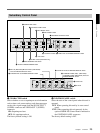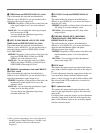
Chapter 1 Overview
Chapter 1 Overview 21
4 Editing control section
PREVIEW REVIEW
AUTO
DMC EDIT
DELETE
MEMORY
TRIM
IN
OUT
IN OUT
AUDIO
ENTRY SHIFT
LIST MARK
-+
EDIT
6 TRIM buttons
7 AUDIO IN button and AUDIO OUT button
8 ENTRY/SHIFT button
9 IN button and OUT button
!º REVIEW button
2 MOMORY indicator
1 DELETE button
3 DMC EDIT button
4 PREVIEW button
5 AUTO EDIT button
1 DELETE button
This deletes an existing edit point.
Hold down this button and press the IN, OUT, AUDIO
IN, or AUDIO OUT button which is lit, indicating an
existing edit point. The button either goes off or
flashes and the corresponding edit point is deleted.
When the button flashes, it is necessary to set the
deleted edit point again.
2 MEMORY indicator
When memorizing the playback speed using the DMC
EDIT button, this indicator flashes as the playback
speed is captured to memory, and lights continuously
once the speed is captured.
3 DMC EDIT button
Use this button to memorize the playback speed varied
between ±1 times normal speed and carry out
automatic playback or automatic editing using the
memorized playback speed.
For information about how to carry out DMC playback or
DMC editing using this button, see the section “Dynamic
Motion Control (DMC) Playback” (page 55) and “DMC
Editing” (page 84), respectively.
4 PREVIEW button
After setting edit points, to preview the editing results
before carrying out the edit, press this button, turning it
on.
If the IN point is not set, the preview is carried out
with the point where you pressed this button as the IN
point.
During the preview the button is lit, and when the
preview ends it flashes.
5 AUTO (automatic) EDIT button
After setting edit points, to carry out automatic editing
(recording), press this button, turning it on.
If the IN point is not set, the automatic editing is
carried out with the point where you pressed this
button as the IN point.
If you pressed the PREVIEW button to carry out a
preview, when the preview ends this button flashes.
6 TRIM buttons
Use these buttons to trim an edit point to single-frame
precision.
Hold down the IN, OUT, AUDIO IN, or AUDIO OUT
button, and press one of these buttons. The MARK/+
button advances the corresponding edit point by one
frame, and the LIST/− button sets it back by one
frame.
During playback, pressing one of these buttons while
holding down the PLAY button adjusts the tape speed
by +8% or −8%, correspondingly. (Capstan override
function)
These buttons are also used for ClipLink operations
and setup menu operations.
For more information about ClipLink operations and setup
menu operations, see Chapter 5 “ClipLink Operation”
(page 97) and Chapter 6 “Setup Menu” (page 107),
respectively.
7 AUDIO IN button and AUDIO OUT button
In insert editing, to set an audio IN point or audio OUT
point separate from the corresponding video edit point,
hold down the AUDIO IN button or AUDIO OUT
button, and press the ENTRY/SHIFT button.
After you have made the setting, pressing the AUDIO
IN button or AUDIO OUT button displays the audio
IN point or audio OUT point set on the time counter
display.


















